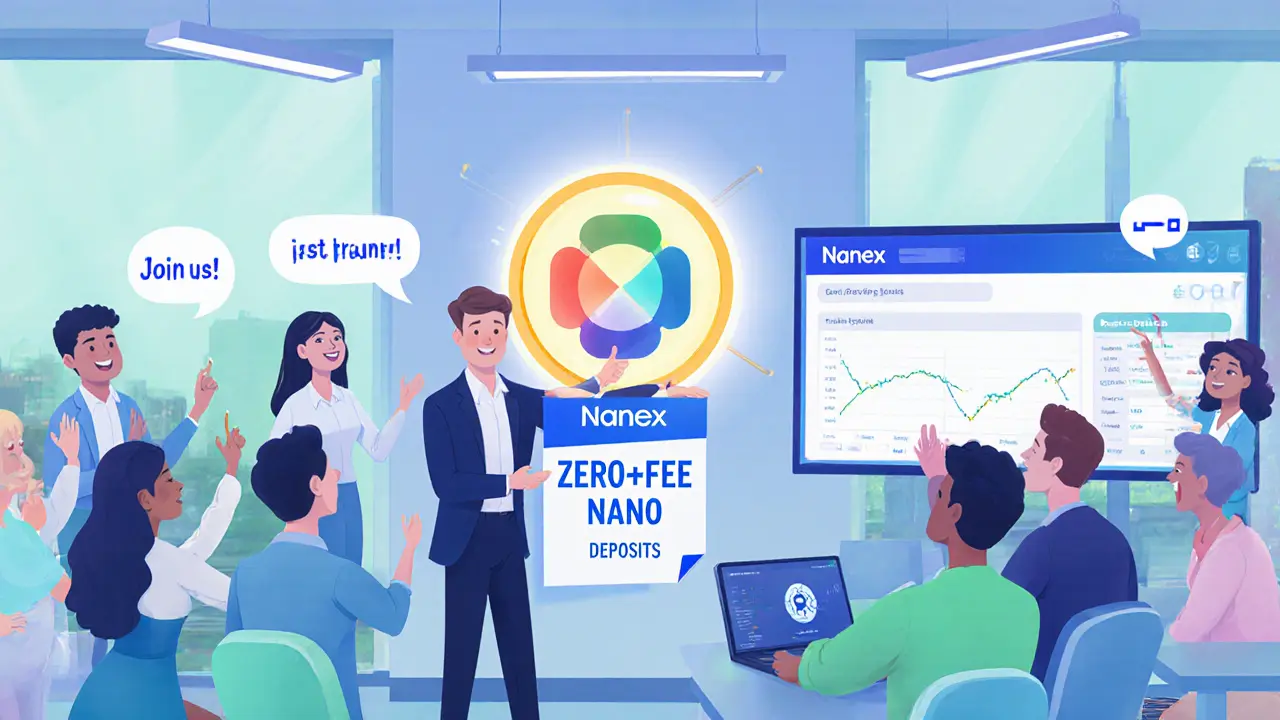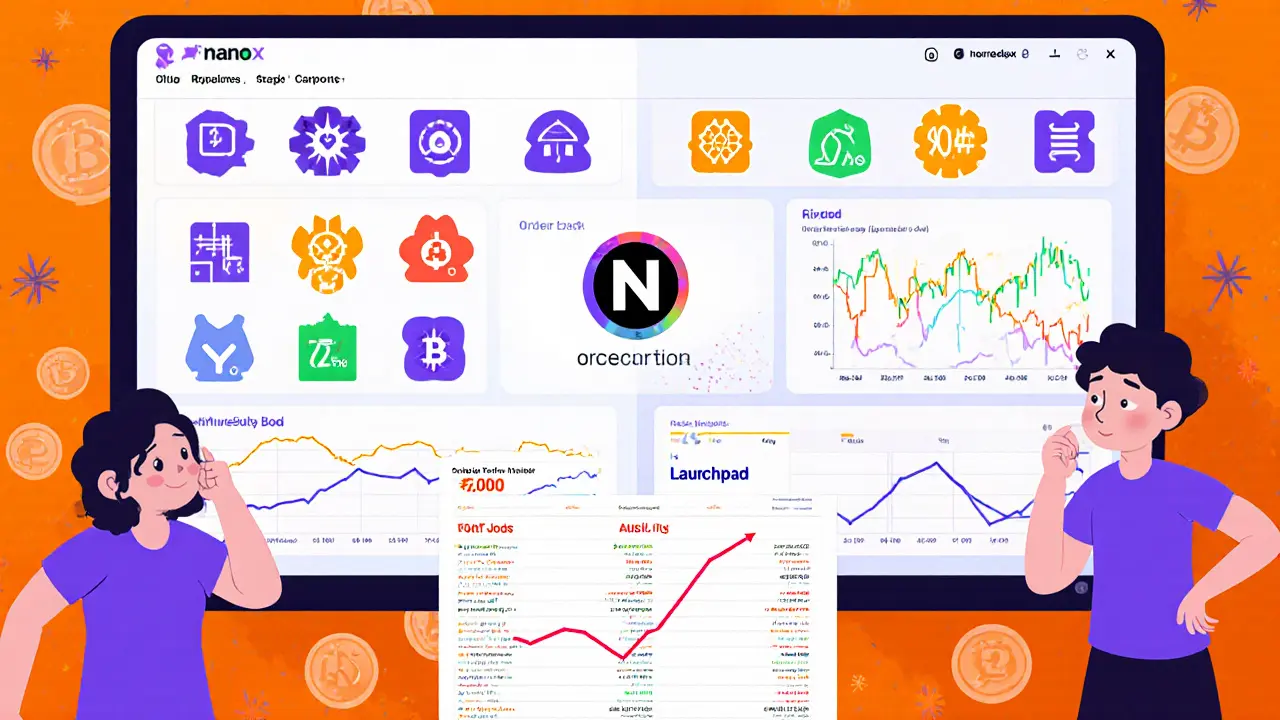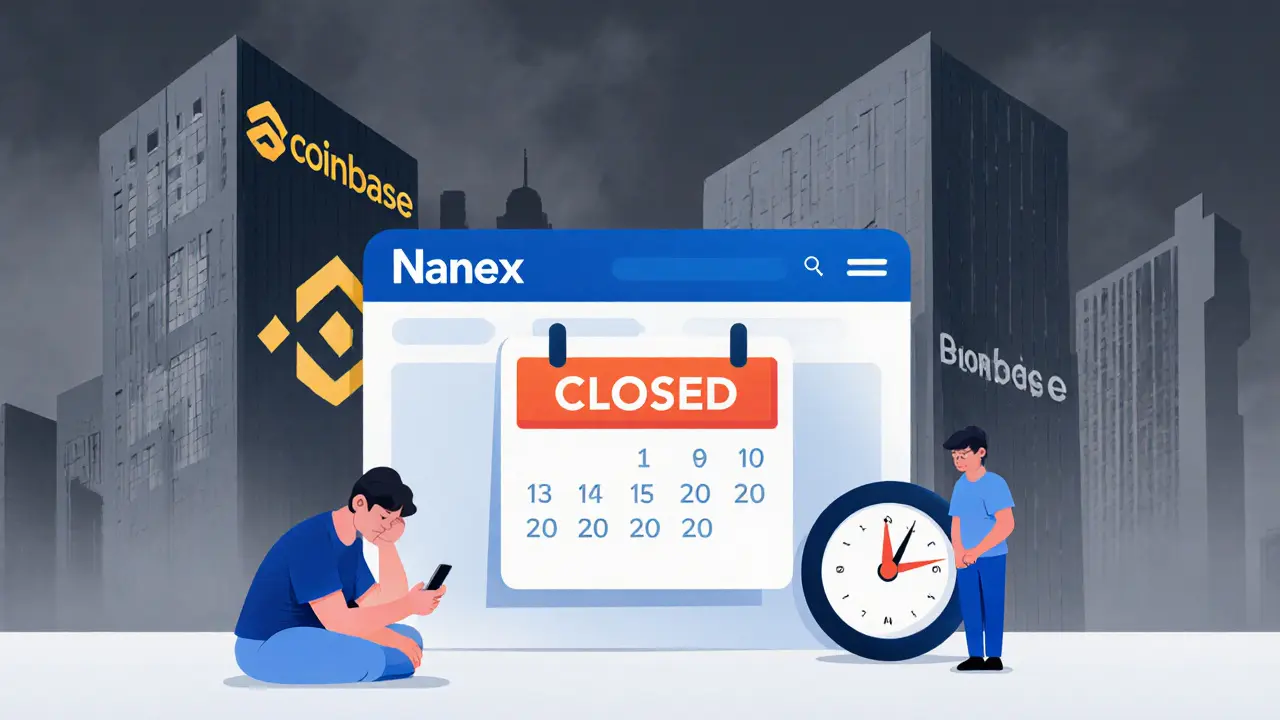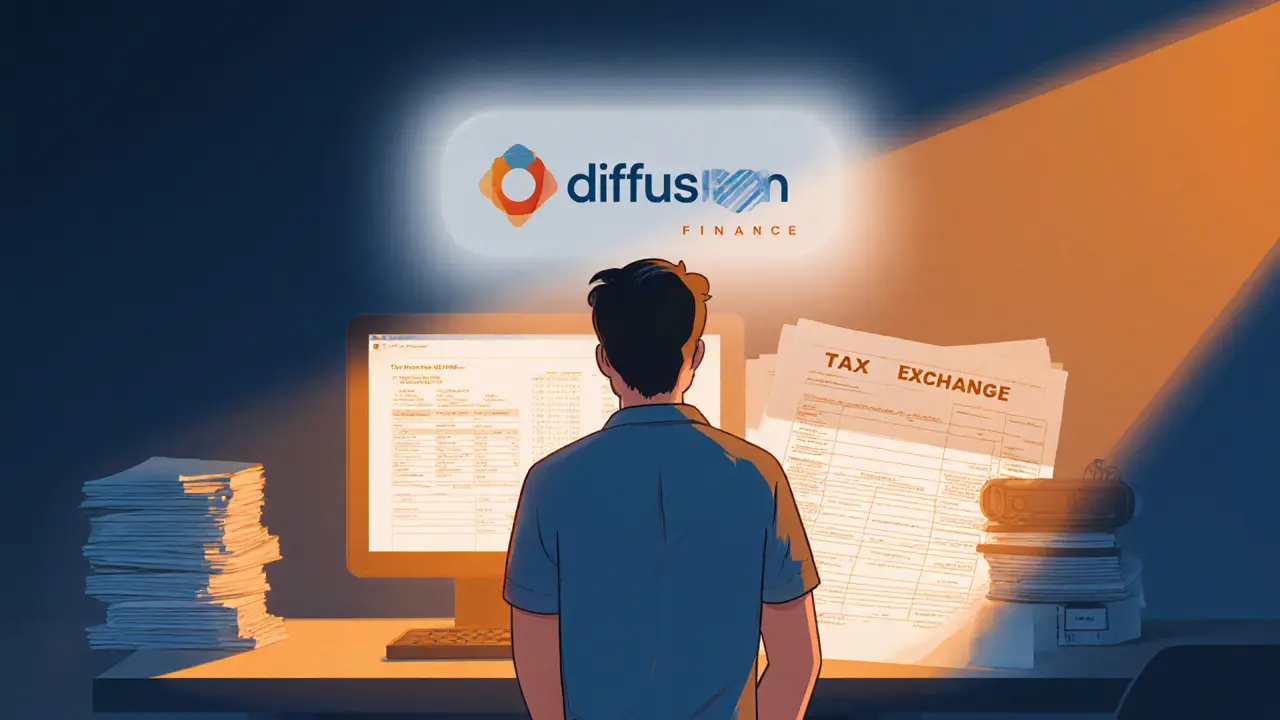
- 4 Mar 2025
- Elara Crowthorne
- 17
Nanex is a centralized cryptocurrency exchange that operated from 2018 to 2025, focusing on the Nano digital asset. It aimed to be the go‑to place for Nano enthusiasts while also supporting a handful of other coins. If you’ve ever Googled “Nanex crypto exchange review,” you probably want to know whether the platform was safe, what it actually offered, and why it vanished. This article walks through the whole story, from launch to shutdown, and extracts the lessons you can apply to any exchange you consider today.
Key Takeaways
- Nanex launched in January2018 as a Nano‑centric exchange with zero‑fee NANO deposits and withdrawals.
- It offered a broad suite of services-margin, OTC, launchpad, fiat gateway-but never attracted enough liquidity.
- Security featured 2FA and an integrated wallet, yet a lack of corporate transparency raised red flags.
- Trading volume dried up to $0 in its final months, and the platform officially shut down on April302025.
- Specialized exchanges can struggle against large, diversified platforms; thorough due‑diligence is essential.
Below is a step‑by‑step breakdown of what Nanex offered, how it performed, and what went wrong.
1. From Idea to Exit: Timeline of Nanex
Nanex entered the market at a time when dozens of crypto exchanges were popping up. Its founders positioned the platform as the “future of cryptocurrency trading” by making Nano the base currency. The timeline looks roughly like this:
- January2018 - Nanex announced its launch, promising zero‑fee NANO deposits/withdrawals.
- Mid‑2019 - Added Bitcoin, Ethereum, Litecoin, Decred, Monero, Garlicoin, Haven Protocol, Lindacoin, and Phore to the roster.
- 2020‑2022 - Rolled out margin & leverage trading, a fiat gateway, credit‑card purchase options, and a desktop app for power traders.
- 2023 - Introduced OTC desk and a launchpad for new token projects.
- Early2024 - Trading volume began to slump; CoinPaprika reported near‑zero 24‑hour volume.
- April302025 - Official shutdown announced on the Nanex website.
While the platform kept adding features, user adoption never took off, and the lack of liquidity became a fatal weakness.
2. Core Features and How They Stacked Up
Nanex tried to compete by bundling a lot of functionality into one place. Below is a quick snapshot of the main features:
- Zero‑fee NANO deposits/withdrawals - The only exchange that let you move Nano without paying a network fee.
- Crypto‑to‑crypto trading - Supported ten coins, all paired against Nano.
- Fiat gateway & credit‑card purchases - Users could buy crypto with USD, EUR, or GBP via a third‑party processor.
- Margin and leverage - Up to 5× leverage on major pairs (see Margin trading is a trading method that allows users to borrow funds to increase position size).
- OTC desk - Direct large‑volume trades without affecting order‑book depth (see OTC trading is a service that matches buyers and sellers off‑exchange for sizable transactions).
- Launchpad - Platform for early token sales, aimed at projects built on Nano.
- Desktop and mobile apps - Windows/macOS client for advanced charting; iOS/Android apps for on‑the‑go trading.
- Integrated wallet with 2FA - Users stored assets directly on Nanex; security reinforced by two‑factor authentication (see Two‑factor authentication (2FA) is a security layer that requires a second verification step beyond the password).
On paper, the feature set looks impressive. In practice, the narrow coin selection and low liquidity meant many of these tools rarely saw real use.
3. Security Measures and Regulatory Gaps
Security is the top concern for any trader. Nanex did a few things right:
- Enabled 2FA for all logins and withdrawals.
- Offered an encrypted online wallet with cold‑storage backups (though the exact cold‑storage process was never disclosed).
However, the exchange fell short in several areas that matter to regulators and users alike:
- Opaque corporate structure - The website never listed a registered company name, headquarters, or executive team.
- Limited jurisdictional compliance - Allowed U.S. users except those in New York and Washington, but provided no AML/KYC documentation.
- Geographical bans - Blocked access from Bosnia and Herzegovina, North Korea, Ethiopia, Iran, Iraq, Syria, Uganda, Vanuatu, and Yemen, yet the reasoning was vague.
Because of these gaps, many analysts warned that users’ assets could be at risk if the exchange faced legal or financial trouble.

4. Market Performance: The Numbers That Tell the Story
Trading volume is the lifeblood of any exchange. When you check historical data on CoinMarketCap is a cryptocurrency data aggregator that tracks exchange volumes, market caps, and price movements, you’ll see Nanex’s 24‑hour volume dropped to $0 in its final months. CoinPaprika is a platform that provides exchange analytics and confidence scores gave Nanex a 0.00% confidence rating, indicating no verifiable trade activity.
Low volume creates two problems:
- Slippage - Orders execute at prices far from the quoted rate.
- Liquidity risk - Large sell orders can’t be filled, leading to stuck positions.
These issues compounded user frustration and accelerated the platform’s decline.
5. User Experience: What Traders Liked and What They Complained About
Community sentiment was mixed, largely because the user base was small and niche. Positive feedback focused on:
- The zero‑fee Nano transfers, which saved users a few dollars per transaction.
- The presence of 2FA, giving a sense of security.
Negative points were more frequent:
- Missing price charts on the web interface - several users reported blank chart windows during peak times.
- Slow order execution due to low liquidity.
- Unclear asset withdrawal process after the shutdown announcement.
Because the exchange catered to a narrow audience, word‑of‑mouth growth never reached a tipping point.
6. Why Nanex Closed Its Doors
Three main forces pushed Nanex toward the exit:
- Liquidity shortage - Without sufficient trade volume, the platform could not cover spreads or offer competitive pricing.
- Regulatory pressure - The lack of a clear legal entity made compliance costly, especially as global regulators cracked down on unregistered exchanges.
- Competitive landscape - Major players like Binance, Coinbase, and Kraken offered hundreds of coins, deep order books, and robust compliance programs. Nanex’s niche focus could not compete.
The final shutdown notice advised users to withdraw any remaining funds within 30 days. Those who missed the window potentially faced lost assets.

7. Lessons for Traders Choosing an Exchange
Even though Nanex is gone, the story offers timeless advice:
- Check corporate transparency - Look for a registered company, clear physical address, and disclosed leadership.
- Assess liquidity - Use tools like CoinMarketCap or CoinGecko to view 24‑hour volume and order‑book depth.
- Prioritize security - Ensure the exchange offers 2FA, cold storage, and regular security audits.
- Understand jurisdictional compliance - Verify that the platform follows AML/KYC rules in your country.
- Beware of overly narrow focus - Specialized platforms may look attractive but can suffer from low liquidity and higher risk.
By applying these checkpoints, you’ll reduce the chances of ending up with a dead platform like Nanex.
Feature Comparison: Nanex vs. Typical Major Exchange
| Feature | Nanex | Typical Major Exchange |
|---|---|---|
| Primary coin focus | Nano‑centric (NANO base pair) | Multi‑coin (hundreds of pairs) |
| Deposit/withdrawal fees | Zero for NANO, fees for others | Variable fees, usually >0.1% |
| Liquidity (24‑h volume) | Near $0 in final months | Billions of USD |
| Security tools | 2FA, online wallet, limited info on cold storage | 2FA, hardware‑wallet integration, audited cold storage |
| Regulatory info | Opaque, limited KYC | Transparent licensing, global KYC/AML |
| Additional services | Margin, OTC, launchpad, fiat gateway | Staking, futures, lending, NFT marketplace |
Notice how the lack of liquidity and transparency are the biggest gaps. That’s why many traders gravitate toward larger platforms.
Frequently Asked Questions
Is it possible to retrieve funds from Nanex after the shutdown?
Nanex announced a 30‑day withdrawal window in its final notice. If you missed that period, the chances of recovering assets are low unless the exchange’s legal representatives re‑open the process.
What made Nanex different from other exchanges?
Its core differentiator was a focus on Nano, offering zero‑fee NANO transfers and a suite of tools (margin, OTC, launchpad) built around that single coin.
Should I avoid exchanges that specialize in one coin?
Specialized platforms can be attractive for niche features, but they often suffer from low liquidity and higher regulatory risk. Always vet the exchange’s transparency, volume, and security before committing significant funds.
How can I verify an exchange’s liquidity before trading?
Check the 24‑hour trade volume on data aggregators like CoinMarketCap or CoinGecko, and compare the order‑book depth on the exchange itself. Deep order books with tight spreads indicate healthy liquidity.
What security steps should I take regardless of the exchange I use?
Enable two‑factor authentication, use a strong, unique password, and consider moving large balances to a personal hardware wallet. Regularly review the exchange’s security audits and cold‑storage policies.


17 Comments
Seeing Nanex's rise and fall really drives home how vital liquidity is for any exchange. Even with a shiny feature set, without active traders the books dry up fast. The zero‑fee Nano transfers were a neat gimmick, but they couldn't keep the order flow alive. It's a classic case of innovation without market depth. Traders should always double‑check volume stats before committing.
Liquidity isn’t the only beast; regulatory fog can sink a platform just as quick. A flashy UI won’t save you when compliance walls crumble.
Nanex’s story is a vivid reminder that crypto markets thrive on community trust! When an exchange hides its corporate identity, users start to wonder what’s really behind the curtain! The platform’s focus on Nano was bold, yet it also narrowed its appeal to a niche crowd! Zero‑fee NANO deposits sounded like a dream, but dreams need fuel, and that fuel is active trading volume! Margin trading and OTC desks are powerful tools, but without counterparties they become mere decorative features! The lack of transparent cold‑storage procedures left a lingering doubt about asset safety! Regulators worldwide are tightening screws, and any opaque structure becomes a prime target! Even the best UI can’t compensate for slippage that eats away at profits! Users reported blank charts, a symptom of low activity and strained infrastructure! Liquidity drying up to zero essentially turns an exchange into a dead end for orders! The 30‑day withdrawal window was a last‑d i t c h e f f o r t, but many missed the deadline! Comparing Nanox to giants like Binance shows the scale gap in depth and resources! Specialized platforms can succeed if they carve a loyal base, yet Nanex never built that foundation! For future traders, a checklist of transparency, volume, and compliance is non‑negotiable! In the end, the Nanex episode reinforces that excitement must be matched with solid fundamentals!
Here’s a quick checklist you can use before signing up for any exchange: verify the legal entity and its jurisdiction; check 24‑hour volume on reputable aggregators; ensure the platform offers two‑factor authentication and a clear cold‑storage policy; look for AML/KYC compliance documentation; review the fee structure for hidden costs; and finally, test the order‑book depth with a small trade before committing larger amounts.
One could argue that Nanex’s fate was sealed the moment it chose to chase a single coin; destiny, after all, favors the diversified! Yet every venture is a gamble, and perhaps the universe simply wanted to teach us a lesson about over‑specialization!!!
The whole thing feels like a case study in hubris; flashy features without substance are just empty promises.
Oh great, another “niche” exchange that thought it could out‑play the big dogs by focusing on a single crypto – what could possibly go wrong?
i totally get u, its sad when a platform you liked just disappears lol hope u find a better one soon :)
It is advisable for investors to prioritize platforms that disclose corporate information, present verifiable audit reports, and maintain substantial market depth. Such criteria mitigate counter‑party risk and ensure regulatory adherence.
Don’t trust any exchange that hides who runs it – that’s how the “big one” gets us.
Good luck out there, keep your trades small till you know the waters.
From a technical standpoint, the absence of a robust market‑making engine led to order‑book thinning, resulting in pronounced slippage during peak volatility. Moreover, the platform’s API rate limits were insufficient for high‑frequency strategies, further discouraging liquidity providers.
Liquidity is king.
Choosing an opaque exchange is a moral failing; we must demand transparency to protect our community.
Indeed, the moral imperative is clear: without full disclosure, users are left vulnerable, and the market suffers as a consequence; therefore, the onus lies squarely on exchanges to provide verifiable information!!!
To sum up: check transparency, verify liquidity, and ensure security measures before allocating funds.
Everyone talks about liquidity, but the real hidden danger is that secret agencies could be siphoning data from these “transparent” platforms – stay vigilant, verify sources, and never trust the surface!